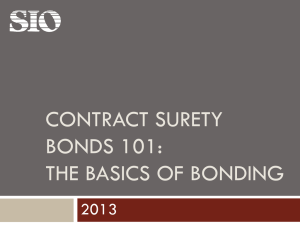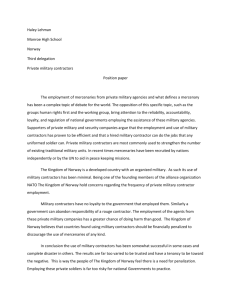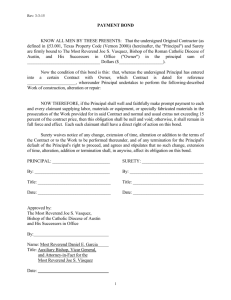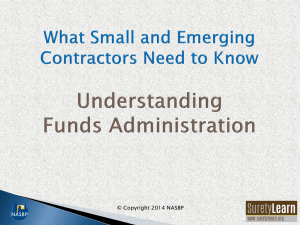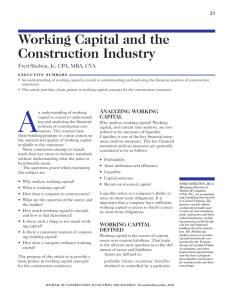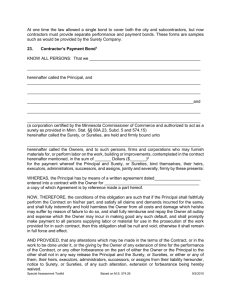Why Do Contractors Fail? - The Surety & Fidelity Association of
advertisement
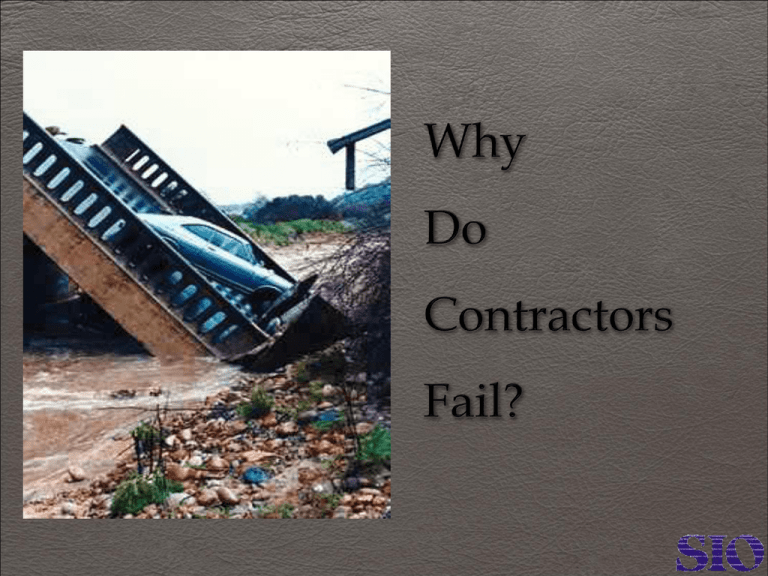
Failure Rates: 2002-2012 Building, heavy/highway, and specialty trade contractors In Business Survivors Failure Rate 853,372 (2002) 610,357 (2004) 28.5% 850,029 (2004) 649,602 (2006) 23.6% 1,155,245 (2006) 919,848 (2008) 20.4% 897,602 (2009) 702,618 (2011) 21.7% 918,483 (2010) 696,441 (2012) 24.2% Source: BizMiner Prequalification Financial Strength Character Equipment Credit History Banking Relationships Experience Contractor Failure Risks Low profit margins Slow collections Onerous contracts RISK Unreasonable owners High Materials prices Insufficient Capital Shortage of qualified, skilled workers Contractor Failure Risks Inadequate Management Change in Scope of Work New Owner RISK Sub Failure Over Expansion Materials Shortages Inclement Weather Reasons for Contractor Failure Accounting Problems Change in Leadership Scope of Business Unrealistic Growth Material/ Equipment Shortages Labor Difficulties Lack of Experience Failure Accounting Issues Inadequate cost tracking systems Estimating or procurement problems Underinsured Improper accounting practices Management Issues Leadership changes No continuity plan when key person dies or becomes disabled Personnel Issues Key staff leave company Character issues Performance Issues Unrealistic growth Change in type or scope of work Poor project selection Onerous owners Unsettled claims & change orders Unrealistic Growth Increase in Backlog Work Shorter Lead Time Unrealistic Growth Factors Beyond Control Economic Downturn Weather Delays Labor Difficulties Inflation Failure Site Conditions Materials Shortages Ineffective Financial Management System Tight cash flow Slow receivables Past due bills Vendors demanding cash Bank Lines of Credit Constantly Borrowed to Limit All credit fully secured Lines not renewed Poor Project Management Inadequate supervision Not getting best prices Projects behind schedule Claims Litigation No Comprehensive Business Plan No contingency plans No“road map” No goals No objectives Poor Estimating & Job Cost Reporting Revenue & margins decrease Continued operating losses Loss of bonding capacity Bid jobs too low Communication Problems Disputes between contractor and owner Poor communication from field to management Loss of Loyal Customers Decreasing reputation for company’s ability to perform contracts on time & within budget Tips for Contractors to Avoid Default Contractors Rights & responsibilities Capabilities Growth & overhead Causes & warning signs Communication Tips for Contractors to Avoid Default Contractors Contract Bond forms Qualify surety Qualify owner Surety Relationship Tips for Contractors to Avoid Default Contractors • Construction-oriented CPA • Adjust overhead • Bank credit • Conserve capital • Bond subcontractors Claims Expectations Rights Resolution Completion Obligations Tips for Owners – Navigating a Claim Owners • Understand bond • Cooperate • Comply with contract • Don’t overpay • Lien waivers • Timely default • Termination For More Information Surety Information Office (SIO) www.sio.org | sio@sio.org SIO is a joint initiative of The Surety & Fidelity Association of America (SFAA) and National Association of Surety Bond Producers (NASBP).



